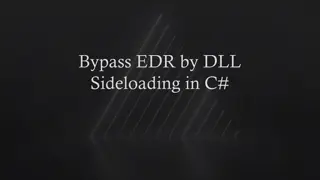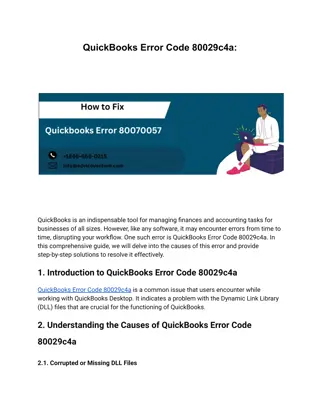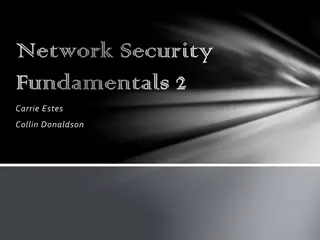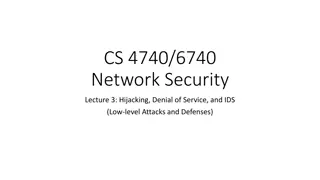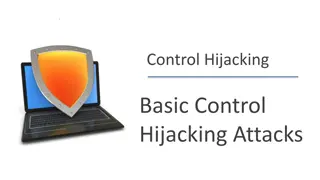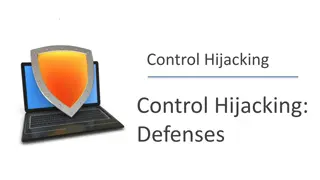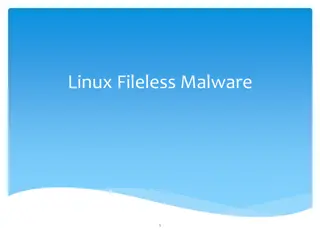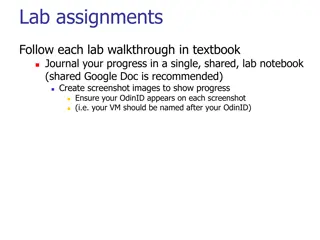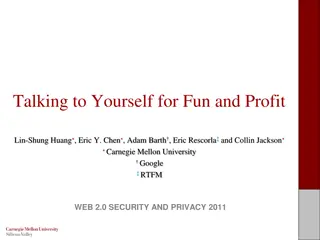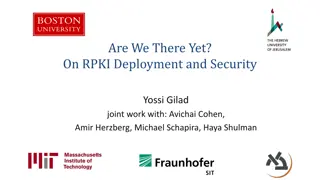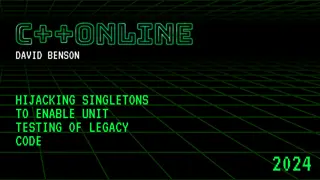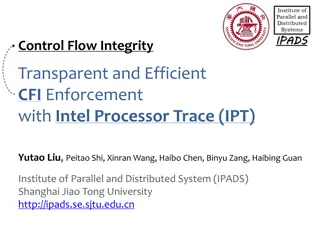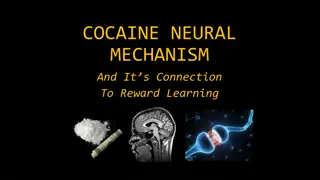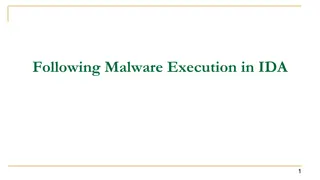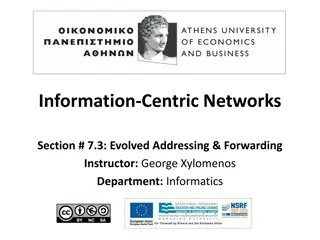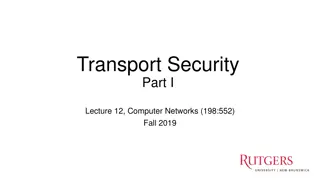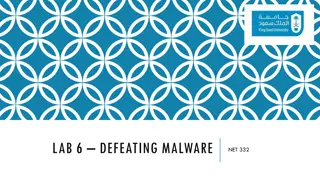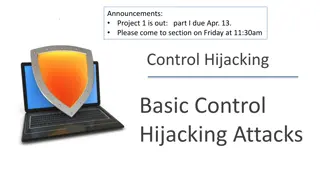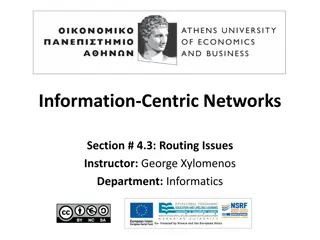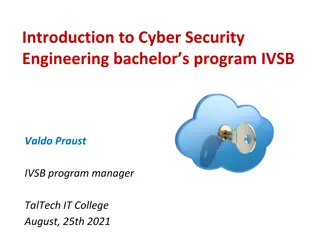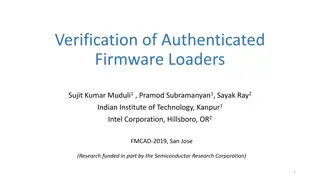Understanding DLL Sideloading Techniques in C#
Explore bypassing EDR using DLL sideloading in C#, finding a vulnerable EXE, testing with OleView.exe, inspecting original DLL functionality, and writing DLL exports in C# for adversarial security testing.
0 views • 19 slides
Resolving QuickBooks Error Code 80029c4a: A Comprehensive Guide
QuickBooks Error Code 80029c4a: \nQuickBooks Error Code 80029c4a is a common issue indicating problems with DLL files. Causes include missing or corrupted DLL files, antivirus interference, incomplete installations, or Windows registry issues. Symptoms include frequent freezing, crashes, and error m
2 views • 5 slides
Understanding Network Security Fundamentals and Common Web Application Attacks
Learn about the basics of network security, including common web application attacks such as Cross-Site Scripting (XSS), SQL Injection, and Session Hijacking. Explore important concepts like cookies, markup languages, and ways to enhance security to protect against cyber threats.
0 views • 11 slides
Understanding Network Security: Hijacking, Denial of Service, and IDS
This content delves into the concepts of spying and hijacking in network security, covering topics such as eavesdropping on packets, injecting packets into streams, denial of service attacks, and defense mechanisms like firewalls and IDS. It explores low-level attacks and defenses, including ARP cac
1 views • 81 slides
Understanding Control Hijacking Attacks in Software Systems
Control hijacking attacks, such as buffer overflows and format string vulnerabilities, allow attackers to take over a target machine by manipulating application control flow. Knowledge of C functions, system calls, CPU, and OS used is crucial for executing these attacks successfully. This summary pr
1 views • 55 slides
Understanding Control Hijacking Attacks and Defenses
Control hijacking attacks pose a significant threat by allowing malicious actors to manipulate data and control flow within a system. This article explores common attack methods like stack smashing and heap spraying, along with defenses such as fixing bugs, implementing platform defenses, and markin
1 views • 36 slides
Enhancing Chapel Compiler with Interfaces and Semantic Changes
Explore the evolution of Chapel compiler with the integration of interfaces, semantic modifications, and improvements in error messages. Delve into the concepts of constrained generics, function call hijacking prevention, and the impact on compiler efficiency.
0 views • 30 slides
Understanding Data Link Layer in Computer Networking
The Data Link Layer (DLL) is the second layer of the OSI model, responsible for error detection and correction, framing, addressing, synchronization, flow control, and multi-access protocols. It deals with logical link control and media access control, addressing destination hardware, avoiding data
0 views • 49 slides
Understanding Common Injection Attacks in Windows and Linux Systems
Dive into the world of injection attacks, exploring the differences between DLL injection in Windows and Linux, the risks of command injection, and the nuances of code injection. Learn about attack scenarios, code examples, and mitigation strategies.
1 views • 104 slides
Cybersecurity Lab Assignments and Walkthroughs
Dive into hands-on cybersecurity lab assignments following detailed walkthroughs from the textbook. Document your progress in a shared lab notebook with screenshots. Explore topics such as malware analysis, DLL inspection, network functions, assembly code analysis, and more across various chapters o
0 views • 19 slides
Web Security Threats and Vulnerabilities: An Overview
Understanding the risks associated with web security, including issues like IP hijacking, cache poisoning, and transparent proxies. Explore how existing approaches fall short in protecting against malicious attacks and potential exploits, with observed vulnerabilities highlighting the importance of
0 views • 17 slides
Enhancing Interdomain Routing Security with RPKI
This content explores the deployment and security aspects of Resource Public Key Infrastructure (RPKI), a system that maps IP prefixes to their owning organizations to prevent prefix/subprefix hijacks. It delves into prefix and subprefix hijacking scenarios, certifying ownership with RPKI, and how R
0 views • 29 slides
Unit Testing Legacy Code: Hijacking Singletons for Testing
Enabling unit testing of legacy code requires making changes without altering existing calling code. Singleton pattern poses challenges for testing, but strategies such as hijacking can be employed for effective unit testing. David Benson shares insights on legacy code attributes and unit testing ap
0 views • 39 slides
Transparent and Efficient CFI Enforcement with Intel Processor Trace
This research discusses Control Flow Integrity (CFI) enforcement to combat control flow hijacking attacks. It explores methods for runtime CFI enforcement, including instrumented checking and transparent monitoring. The study delves into trace mechanisms, buffer management strategies, and when to tr
0 views • 32 slides
Understanding Cocaine's Neural Mechanism and Reward Learning Circuit
Cocaine affects the brain's reward circuit by blocking dopamine transporters, leading users to associate the drug with a rewarding feeling. Prolonged use can result in internalization of dopamine receptors. By hijacking reward-learning mechanisms, cocaine becomes one of the most harmful and addictiv
0 views • 13 slides
Understanding Malware Execution and DLLs in IDA
Exploring how malware executes in IDA Pro, the significance of control flow graphs, DLL review, methods of utilizing DLLs for malicious activities, analyzing DLLs for code execution, and the management of processes in a secure environment. Gain insights into malware behaviors involving DLLs and proc
0 views • 27 slides
Understanding DLL Hijacking in Windows
Dynamic-Link Libraries (DLLs) are a mechanism in Windows for sharing code and data, making it easier to design and build applications. By loading DLLs either statically at compile time or dynamically at runtime, programs can enhance memory management and user experience. However, DLL hijacking, a co
0 views • 13 slides
Understanding Software Security Fundamentals
This review delves into essential concepts of software security, covering topics such as basic execution models, parameter areas, control flow hijacking, channeling vulnerabilities, buffer overflows, and format strings. It explores stack diagrams and analysis, elucidating critical mechanisms like co
0 views • 17 slides
Evolved Addressing and Forwarding in Information-Centric Networks
The content discusses Evolved Addressing and Forwarding in Information-Centric Networks, focusing on an accountable Internet protocol (AIP) that addresses vulnerabilities at the IP level, such as source spoofing, DoS attacks, and route hijacking. AIP utilizes a hierarchy of self-certifying addresses
0 views • 16 slides
Understanding Network Security Fundamentals in Computer Networks
Explore the importance of network security in Computer Networks, focusing on key aspects like confidentiality, integrity, authentication, and non-repudiation. Learn about common threats, such as eavesdropping, impersonation, hijacking, and denial of service attacks, and the role of cryptography in e
0 views • 28 slides
Understanding Malware: Types, Risks, and Removal Methods
Explore the world of malware, including its various types and how it infiltrates systems. Discover the dangers it poses, such as data theft and system hijacking, and learn about manual removal techniques using tools like MBAM. Dive into hands-on labs to analyze, detect, and eliminate malware for a s
0 views • 15 slides
Understanding Control Hijacking Attacks in Computer Systems
Explore the concept of control hijacking attacks in computer systems, including buffer overflows, format string vulnerabilities, and use-after-free exploits. Learn about the attacker's goal, examples of attacks, and the importance of understanding C functions, the stack, and the heap. Delve into sys
0 views • 39 slides
Understanding Routing Issues in Information-Centric Networks
This section delves into the routing issues within Information-Centric Networks, highlighting vulnerabilities such as misconfigured routers, prefix hijacking, and impersonation. It emphasizes the importance of validating routes and proposes improvements to address security concerns associated with B
0 views • 15 slides
Comprehensive Guide on XSS Attacks and Defense Strategies
Explore the intricate details of Cross-Site Scripting attacks, the anatomy of XSS attacks, safe ways to represent dangerous characters in web pages, defense mechanisms based on data types and contexts, and the significance of encoding and output handling. Learn how attackers misuse XSS to hijack ses
0 views • 32 slides
Cyber Security Engineering: Understanding the Importance and Examples
Cyber security is crucial due to the uncontrollable nature of digital devices and the potential for unauthorized access and manipulation, leading to severe consequences like data leakage, information distortion, and unauthorized access. Two examples illustrate the real-world implications of cyber th
0 views • 20 slides
Virtual Meeting Security Best Practices
Ensure the security of your virtual meetings by following best practices to mitigate threats like teleconference hijacking. Consider tools like Zoom, Skype, Webex, and others to host secure meetings. Avoid making meetings public, manage screen-sharing options, use waiting rooms, validate participant
0 views • 23 slides
Authenticated Firmware Loaders: Verification and Potential Vulnerabilities
This research paper explores the verification of authenticated firmware loaders presented by Sujit Kumar Muduli, Pramod Subramanyan, and Sayak Ray. It delves into the secure boot process to prevent malicious firmware compromise. The study also discusses trusted firmware updates for remote device sec
0 views • 29 slides
